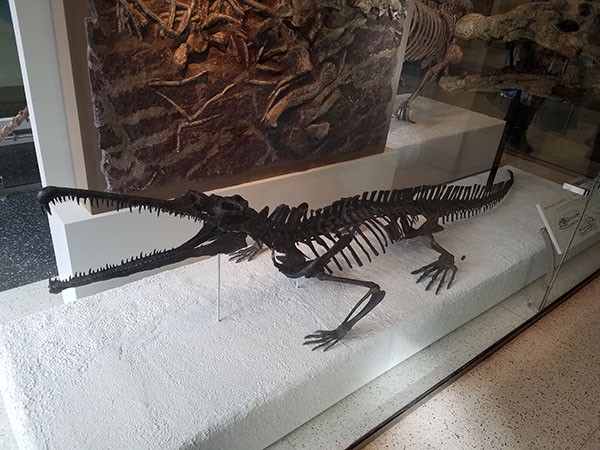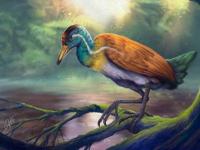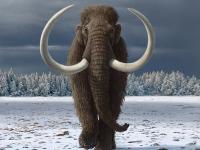How a Humble Chatham County Phytosaur Crawled into History Before the Mighty T. rex

If you visit the Hall of Vertebrate Origins at the American Museum of Natural History, you'll find a mounted skeleton of Rutiodon carolinensis, a member of the superficially crocodile-like order Phytosauria. This long-lived and diverse group inhabited North America during the Triassic period, from around 250 million to 200 million years ago. If you look closely at the signage, you'll notice that this skeleton, specimen AMNH-FR-1, was the very first cataloged in the museum's fossil reptile collections.
The AMNH is famous for spectacular mounted skeletons of dinosaurs from the badlands of Mongolia and the American West, but this skeleton, you might also notice, is said to come from the verdant hills of Chatham County, North Carolina. So how did this humble Carolina crocodylomorph make its way to Central Park West before the first Tyrannosaurus or Triceratops?
The AMNH signaled its intention to build a major vertebrate paleontology program in 1891, when it hired Henry Fairfield Osborn. Osborn's interest in North Carolina appears to date from the 1880s, when he published a short paper on two jaws from mammal relatives called cynodonts. They had been found in Chatham County coal mines by Ebenezer Emmons, North Carolina's first state geologist. Emmons's visits to the mines in the 1850s also yielded fragmentary phytosaur fossils that he would give the name Rutiodon ("wrinkled tooth") carolinensis ("of Carolina"), a new species.
Over the summers of 1894 and 1895, Osborn dispatched his newest assistant curator, William Diller Matthew, to North Carolina, on a search for more early mammals. Matthew would eventually become a pioneer of modern American mammalian paleontology. A creative theorist and a careful researcher, he did much to bring order to the chaos created by the exuberance of some nineteenth-century paleontologists. His North Carolina expeditions were his first for the AMNH.
Matthew began work in the Egypt Coal Mine (now in the community of Cumnock), one of a string of mines along the Deep River from Gulf to Sanford that operated sporadically from the 1810s until the 1920s. The coal deposits of Chatham and Lee counties had formed in swamps in the rift basins created as the African plate pulled apart from North America beginning about 220 million years ago. Phytosaurs were important predators in these swamp ecosystems and were common enough fossils to be well-known to the miners. Matthew returned to New York in 1895, frustrated in his efforts to find additional fossil mammals but with a large quantity of phytosaur material.
The specimen cataloged as AMNH-FR-1 is a composite of a skull and a number of skeletal elements, likely from multiple creatures found in the Egypt mine in close proximity. The skeleton was mounted some time before 1906, when it first figured in a monograph, and again in the 1940s, using information acquired from additional Rutiodon discoveries. As such, Rutiodon carolinensis was among the first ancient reptiles to be represented by a museum-mounted skeleton.
Rutiodon wouldn't reign long as king of AMNH reptiles, though. Later in 1895, the museum acquired the thousands of fossils collected by famous and fractious Philadelphia paleontologist E.D. Cope over his long career. This included many important dinosaur specimens that would find their place in the fossil reptile collections inaugurated by Matthew's North Carolina phytosaurs. But fossils of phytosaurs, mammal relatives, and other contemporaneous animals have continued to emerge from rocks of the Triassic basins of central North Carolina, providing key insights into this period of the evolution of North America.
Source: www.indyweek.com








